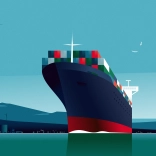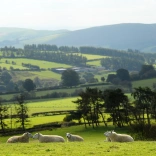Let’s begin at the top. Our highest mountain, Yr Wyddfa (Snowdon), is one of the most visited peaks in the British Isles. It’s also among the most accessible, thanks to the famous cog railway that has been whisking travellers up to the summit since 1896.
Hiking up there is more of a challenge. The Llanberis Path is the gentlest route (though also the longest – there’s always a pay-off) while the Crib Goch Ridge is an epic scramble to rival anything in the Alps, and strictly reserved for sure-footed experts. The great leveller is that however you get up to the summit, some 1,085m (3,560ft) above the sea, you’ll be treated to the same sublime views. On a clear day, you can turn on your heels like a weather vane and pick out England, Scotland and Ireland at different compass points.


Wales has other regions of wild uplands to explore, too – including the Cambrian Mountains, the hilly spine that dominates Mid Wales. Legend holds that the tallest point, Plynlimon, is a sleeping giant. That doesn’t seem so fanciful when you stand on the shoulder-like summit, some 752m (2,467ft) above a vast area of moorland that’s a magnet for adventurous walkers and 'bikepackers' on two-wheeled camping expeditions.

The Bannau Brycheiniog (Brecon Beacons) National Park in South Wales is a dream for hardcore hikers and casual strollers alike. There are plenty of cosy B&Bs in lively market towns such as Abergavenny, Crickhowell and Brecon to serve as base camp. Other ranges such as Pembrokeshire’s Preseli Hills and Carmarthenshire’s Black Mountain, both in the South West of Wales, are perfect for those looking to get off the beaten path, notch up some lesser-known summits and earn real bragging rights.

Around 15% of Wales is forested. Our woodland creatures include a growing population of mountain bikers, taking advantage of some of the best trails on the planet. Enthusiasts endlessly debate which are the most exciting, from Coed-y-Brenin near Dolgellau to Nant-yr-Arian above Aberystwyth. And for those who want the thrill of speeding downhill without the schlep back to the top, both BikePark Wales near Merthyr Tydfil, South Wales and Antur Stiniog in Eryri (Snowdonia), North Wales, have an uplift service for bikes and riders.
As anyone familiar with the Arthurian legends will know, Wales is a land of lakes. Some are natural, some man-made, and many are stunningly beautiful. Lake Vyrnwy, set in the heart of a nature reserve, is a real showstopper – not least for the Victorian engineering of its stone dam and Disney-like tower.


It’s a plum spot for dinghy sailing and a popular stopping-off point on Glyndŵr’s Way, one of our most taxing long-distance footpaths. South Wales’ largest natural lake, Llangorse in the Brecon Beacons, is Vyrnwy’s equal in looks, and noted for adventure sports on water and dry land alike.
All that water has to get to the sea somehow. Rivers such as the Dee and Tryweryn in North Wales include rapids to test the skill of the most experienced kayakers and rafters. If that's not enough of a challenge, Cardiff International White Water has an Olympic-standard course with plenty of twists, turns and big drops.


The languid waters of the lower Wye and Usk are perfect for a less strenuous paddle. You could even try out one of Wales’ newest outdoor activities – packrafting. It’s a combination of hiking and rafting that allows you to explore the hills, lakes and rivers on the same expedition, carrying your river craft with you.
Out on the edge of Wales you’ll discover an awe-inspiring coastline, all traced by the 870-mile (1,400km) Wales Coast Path. Highlights include the Glamorgan Heritage Coast where the striped cliffs reveal millions of years of geological history, the wild bays of north Pembrokeshire, and quiet sections such as Point Lynas on Anglesey – one of the best places in Britain for spotting dolphins and porpoises.


For thrill-seekers who aren’t afraid of heights, an unforgettable urban adventure can be found at Cardiff's Principality Stadium with Scale The Stadium. Ascend to breath-taking views on the roof of the stadium, inch your way around the spire walkout over the River Taff, then zip line across the stadium roof, and abseil back to earth.
For those captivated by the thrill of flight, Zip World offers an unmatched aerial adventure across four sites in Wales. Experience the world's fastest zip line at Penrhyn Quarry, explore underground at Llechwedd Slate Caverns, enjoy lush woodland adventures at Fforest near Betws-y-Coed, and tackle Europe’s highest zip line at Tower in Rhondda Cynon Taf. Each site combines adrenaline with stunning Welsh scenery, perfect for adventure seekers eager to conquer the skies and underground depths.


Coasteering is a Welsh gift to the adventuring world, invented around St Davids in South West Wales some 30 years ago. One of its pioneers, Andy Middleton of TYF Adventure, describes it as “a unique and intoxicating combination of climbing, scrambling, leaping and swimming along the coastline”.
Much of the coastline is perfect for surfing, where you can share the waves with what former European longboard champion Chris Griffiths of Mumbles calls “an eclectic bunch of characters from all walks of life”. It's even possible to go surfing inland if you visit Surf Snowdonia in Adventure Parc Snowdonia – an artificial lagoon where perfect waves are guaranteed and suitable for beginners or more experienced riders.

Beautiful, remote islands such as Skomer, Skokholm and Ramsey in the south and Bardsey in the north (all named by Viking visitors many centuries ago) are ideal to explore on a boat expedition. Apart from your fellow passengers, your company may include seals, dolphins, porpoise and whales in the water, and gannets, puffins and guillemots in the air.
From the tip of Yr Wyddfa (Snowdon) to the Atlantic waves that break on the Gower Peninsula, Wales is a nation where you can choose your own adventure.

Be safe!
Exploring the outdoors is fantastic fun, but please read up on the risks and make sure you are prepared.
- Find safety advice for exploring Wales' National Parks and safety tips for staying safe on the Welsh coast, on the Visit Wales website.
- Visit AdventureSmart.uk for information on how to stay safe whilst exploring Wales.




